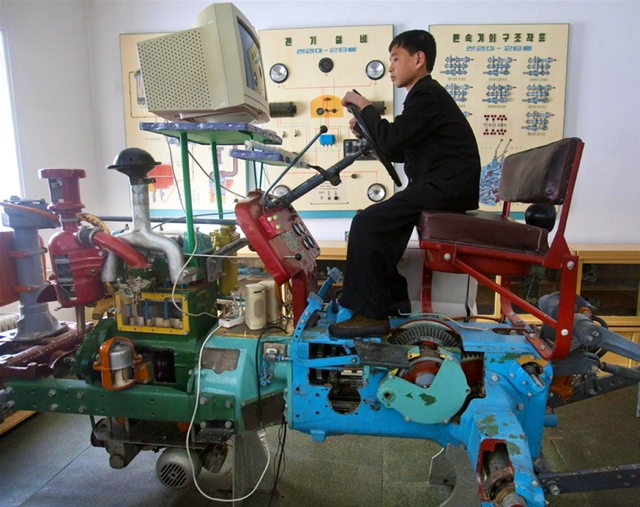 It’s not often that the forces of IT and agriculture are united, but in its quest for agrarian supremacy, North Korea has devised a novel (if slightly odd) method to help educate its children in the ways of farming. Using an ’80s style monitor along with the gutted chassis of a Soviet-era tractor, it has created a unique computerised simulator in an attempt to help school children learn the ways of their forefathers. Admitedly, it lacks the form factor of the latest GPS devices, but it does have a certain retro charm.
It’s not often that the forces of IT and agriculture are united, but in its quest for agrarian supremacy, North Korea has devised a novel (if slightly odd) method to help educate its children in the ways of farming. Using an ’80s style monitor along with the gutted chassis of a Soviet-era tractor, it has created a unique computerised simulator in an attempt to help school children learn the ways of their forefathers. Admitedly, it lacks the form factor of the latest GPS devices, but it does have a certain retro charm.
Despite its somewhat Heath Robinson appearance, the contraption apparently makes a dramatic difference in a school curriculum which has a strong practical emphasis on trade skills and vocational work. Pupils learn how to plough virtual fields whilst their counterparts in Europe learn how to mow down innocent pedestrians via the likes of the popular video game, Grand Theft Auto. Okay, perhaps that’s a slightly implausible comparison, but it is somewhat indicative of a disparity between our respective cultures.
Moreover, it begs the question of why we aren’t more proactive in our use of technology in the quest for safer roads. The driving test has incorporated a hazard perception assessment for a good many years, but the process hardly replicates experiences on the road.
Watching a selection of video clips and clicking a mouse button when you see a dangerous (or blindingly obvious) situation is hardly representative of modern driving conditions. For today’s youth, it may be slightly more realistic if it was done under the influence of a Greggs’ stake bake, whilst thumbing through a Sat Nav menu and composing a text message. With such a multi-sensory world of gadgets and computer tech, it’s little wonder that as many as twenty percent of young drivers have had an accident. In fact, a recent study found that some 13.2% of 17 year old drivers and 12.85% of 18 year old drivers have been involved in collisions. This is considerably higher than the average 6.5% across all other age groups for a similar one-year period. So, what’s to be done?
Well, I’d humbly suggest that the use of sophisticated simulator technology could make a considerable difference to the safety record of the nation’s youth. Although we often hear stories of irresponsible driving at silly speeds, such situations are, thankfully, the exception.
According to Direct Line, the primary cause of accidents amongst young drivers is lack of experience. This leads to either a dangerous overconfidence, or a panic situation, where a lack of familiarity with the road ensures bad situations get worse very quickly. The solution, it would seem, is to allow young drivers to clock up more hours practice without putting them in harm’s way. Commercial airline pilots need to log in more than 250 hours’ on the flight deck before they get their license and even then, they’ll be accompanied by a senior first offer or captain until they get to the point they can command their own airliner.
Of course, airplanes are slightly more advanced than the humble motorcar, which certainly doesn’t cost anywhere near the amount of your average 747 (unless you’ve just filled your tank, in which case it comes close). Finding an effective and inexpensive system that accurately recreates some of the scenarios today’s young drivers are likely to face surely isn’t beyond the scope of man. So perhaps it’s time we invested in rolling out a series of driving simulators that will let young drivers rack up a few more miles without the exorbitant costs of driving lessons…or filling up at the forecourt.